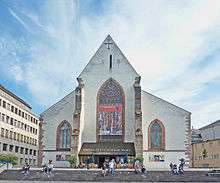Basel Historical Museum
Opened in 1894, the Basel Historical Museum (German: Historisches Museum Basel) is one of the largest and most important museums of its kind in Switzerland, and a heritage site of national significance.[1]
Three sections
The museum is divided into three sections (buildings), three of which are within the city of Basel. These are Barfüsserkirche, Haus zum Kirschgarten and the Musikmuseum.
Barfüsserkirche

Location and history
The main part of the museum is located in the Barfüsserkirche (literally ‘Barefeet Church’) in the centre of the city of Basel.
On 20 October 1975 workers discovered a brick-walled grave chamber in front of the choir, containing the mummified corpse of a woman. She was identified as Anna Catharina Bischoff and turned out to be an ancestor of Boris Johnson.[2]
Items in the exhibition
The museum houses the Upper Rhine’s most comprehensive cultural history collection and the display area covers 6,200 square meters. The exhibition presents objects documenting handicraft traditions and everyday culture from ages past. Its focus is on the late Middle Ages and the Renaissance up to the Baroque period. Leading highlights include: the treasury of the Basel Cathedral, the Basel and Strasbourg tapestries, the fragments of Basel’s dance of death, altars and ecclesiastical graphic works, the estate of Erasmus of Rotterdam, the coin cabinet and glass painting. The museum also preserves old cabinets of curiosities which have been bequeathed, as Amerbach cabinet and Faesch cabinet, which works great collectors Basel sixteenth and seventeenth century.
Management
The museum is managed by the canton of Basel-City. Its origins lie with the Amerbach family in the 16th century whose Wunderkammer was bought by Basel 1661 and brought to the public 1671. The cultural history objects of this Wunderkammer, together with the ones of other collections, became the Historisches Museum Basel in 1894.
Haus zum Kirschgarten

Location and history
The Haus zum Kirschgarten (House to the Cherry garden) was built between 1777 and 1780 for the Basel trim (sewing) and ribbon industry and for Colonel Johann Rudolf Burckhardt. The house is considered to be the most aristocratic palace in the area. The architect was Ulrich Büchel. After various changes in the ownership, the house was connected to the neighbouring building and a home-living museum was installed.
Items in the exhibition
Most of the 50 exhibition rooms are dedicated to showing typical common living space in Basel during the 18th and 19th century. Shown are varying furnitures, paintings, porcelain and toys and has been extended by a professional collection.
Musikmuseum
Location and history
The Musikmuseum is situated over the Barfüsserplatz, opposite the Barfüsserkirche.
Items in the exhibition
In 21 exhibition rooms over five centuries of European music history is displayed. The exhibition has three main points:
- Instruments from the 16th to the 20th century
- Concerts, choirs and dance
- Parades, ceremony and signal-to-noise
See also
Footnotes
- Swiss inventory of cultural property of national and regional significance (1995), p. 80.
- www.bbc.com, 28 january 2018
External links
| Wikimedia Commons has media related to Historisches Museum Basel. |